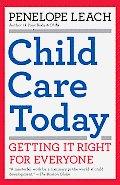
Getting Child Care Right
June 22, 2010
Related Reading

Child Care Today: Getting It Right for Everyone
Penelope Leach
Alfred A. Knopf, Inc.
New York
350 pp., ISBN 978-1-4000-4256-2
$25.95
Parents in need of child care are faced with many important decisions. To whom are they willing to entrust their children while they are away? How much of the day and what part of the week will children spend in child care? Which type of setting best meets their needs? How much of the family budget can and should be spent? Some parents will select from a broad menu of choices, including in-home care by another family member, enrolling in a child care center, or even hiring a private nanny. Others, due to circumstances such as poverty and geography, will have many fewer options. Regardless of their specific circumstances, many parents will struggle in choosing the right child care option for their families.
Even though child care is a fact of life for most families with young children, Penelope Leach emphasizes that “nothing about child care choices is simple or obvious….” (p. 58). In this book, Leach offers a wide-ranging overview of the current landscape of child care, with a particular emphasis on the United States and the United Kingdom. As a key researcher for the large-scale Families, Children and Child Care (FCCC) study in the U.K. and as author of the well-known Your Baby & Child, she is well qualified to succeed at that ambitious goal. This hefty volume is primarily geared toward making parents and the general public more aware of the nuances of child care and the options that may be possible for today’s families.
Leach organizes her book around four major issues, each represented by its own section: the status of child care today, the types of care that are available, the importance of quality, and how the future of child care might look. Since the sections are reasonably self-contained, readers have the option of focusing on topics that are of greatest interest, although the book as a whole makes for compelling reading.
Leach begins by highlighting societal changes that have shaped our current need for child care. Though parents’ (and especially mothers’) lifestyles and work schedules have evolved over time, children below a certain age will always need constant care. This can lead to complex balancing acts. A parent seeking a return to the workforce must arrange for child care that meets the family’s standards of quality while not costing more than the new job brings in. Grandparents and free or low-cost public options may not be readily available. Families must be comfortable with leaving their children in the care of others – sometimes for significant portions of the day – and be able to accept the tradeoffs between work and home life.
With this context established, Leach offers individual research-based summaries of what is known about different types of child care. These helpful chapters address home care by various types of family members and non-family caregivers, as well as more formalized care in child care centers and schools. She also provides overviews of the critical issue of child care quality from the perspectives of researchers, parents, and children. These perspectives are of course part of the difficult calculus in selecting a child care provider. For example, parents’ real-life child care choices may not reflect the features of child care that parents rate as most important, and types of preferred child care arrangements may differ by the age of the child. Leach wraps up her summary of quality by identifying important features of a high-quality child care setting as well as tips on what to avoid.
This book is particularly relevant because in order to get child care right, there is much more hard work that still needs to be done. Parents, child care providers, and governments all bear responsibility for their part in this work. Leach favors national models that have secure funding and integrate both care and education. One possible model is the “social investment state” in which parental self-sufficiency is key but public funding of early care and education is viewed as an important investment in global competitiveness. Leach concludes with a powerful statement on the status of child care today and a guidepost for the future: “Right now, scarcity of child-friendly attitudes throughout the English-speaking world weighs even more heavily against high-quality child care than scarcity of financial or other resources. We can do better.” (p. 297).
Reviewed by Jason Hustedt
Assistant Research Professor, NIEER
About NIEER
The National Institute for Early Education Research (NIEER) at the Graduate School of Education, Rutgers University, New Brunswick, NJ, conducts and disseminates independent research and analysis to inform early childhood education policy.
